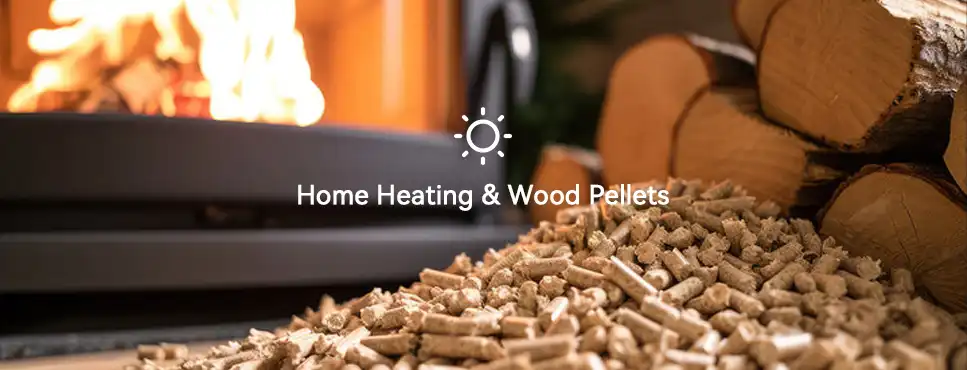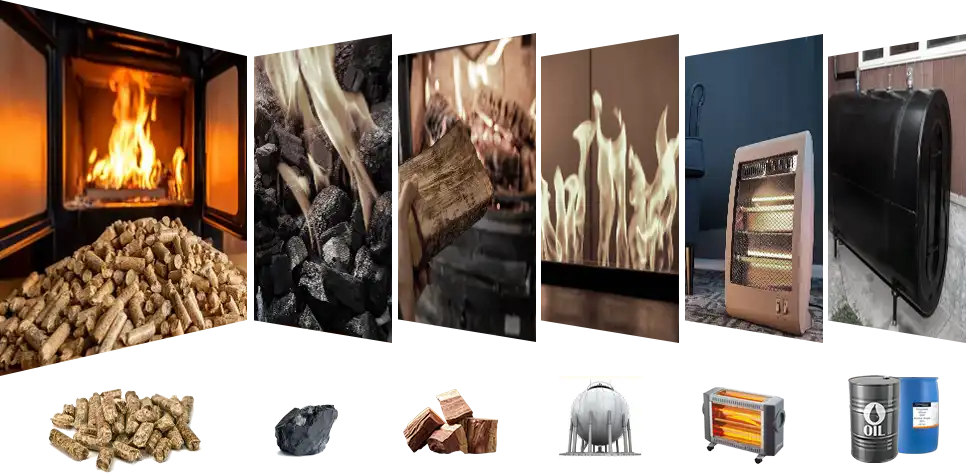Wood pellets are a clean and effective way to heat. Understanding the differences between wood pellets and other energy sources is important. It can help you select the best option for heating your home.

Characteristics of Various Heating Energy Sources
The following are the characteristics of 6 common heating energy sources.
- Using Coal for Heating
Coal is one of the most abundant and affordable fossil fuels, making it easy to obtain and burn. Yet, as a non-renewable resource, it releases carbon dioxide and sulfur compounds when burned. These emissions contribute to air pollution and climate change.
- Using Wood for Heating
Wood is a natural, renewable fuel. It provides instant, stable heat. However, wood takes up more space than pellets and releases harmful gases like carbon monoxide and nitrogen oxides.
- Heating with Natural Gas
A gas-powered fireplace is easy to use-just press a button or flip a switch to start the flame. You can adjust the flame size and temperature with a remote control or the unit's built-in controls. It's simple to operate, burns cleanly, and has low maintenance costs. However, natural gas, like coal, is a non-renewable fuel that pollutes the environment; and it can be more expensive.
- Electric Heating
Electric heaters are a common and easy way to heat a space. They don't need storage and can give heat as long as there is power. Electric heaters usually heat up slowly. Also, using electricity can often cost more than using natural gas or pellets.
- Heating with Oil and Propane
Oil and propane are high-energy fuels that can be stored in tanks, making them suitable for areas without natural gas pipelines. However, oil prices can fluctuate significantly, and burning it creates more pollution. While propane burns cleaner, it is more expensive and has higher long-term costs.
- Heating with Wood Pellets
Wood pellets are solid fuel made from biomass like sawdust, wood chips, and agricultural waste. They are compressed under high pressure and temperature into small, dense pellets. Used in stoves, furnaces, and boilers, wood pellets provide efficient heating for homes, businesses, and commercial spaces. As a renewable energy source, they are cost-effective and environmentally friendly.

Why Choose Wood Pellets over Other Energy Sources?
Here are some reasons you might choose wood pellets instead of other heating energy sources.

Lower Greenhouse Gas Emissions – More Eco-Friendly
Compared to fossil fuels and propane, wood pellets made from sawmill residues offer the most significant reduction in greenhouse gas emissions. Wood pellet fuel can reduce greenhouse gas emissions by 54% compared to heating oil and by 59% compared to natural gas.
A Renewable Resource
Wood pellets come from organic materials, such as leftover wood. Since wood is renewable, new plant growth offsets the carbon dioxide emissions produced during burning, helping to reduce the overall carbon footprint.
Convenient to Store and Transport
Once processed, wood pellets are small, dense, and hard, with a smooth surface. This makes them easy to store and transport, taking up less space and being more manageable than other fuel sources.
Clean Burning
Premium wood pellets have low ash content (typically less than 1%), meaning they leave very little residue after burning. This makes cleanup easy and efficient.
Cost-Effective
Wood pellets usually cost less than fossil fuels like oil or propane. Their prices are also more stable and less affected by swings in the global energy market.
Biomass energy has shown great potential for environmentally friendly and low-emission energy production.Choosing wood pellets as a heating source is not only an environmentally responsible choice but also a wise investment for future energy needs.







